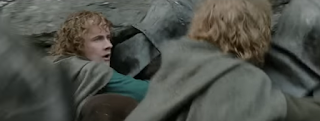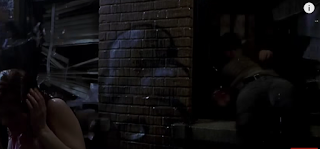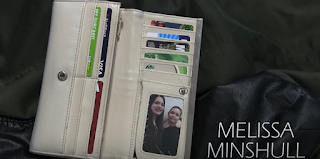In what ways does the media product use, develop or challenge forms and conventions of real media products?
This year's project was to create a 5 minute short film, along with a radio trailer and poster to promote it. I found this year's task much more challenging than last year's as the film had to be much longer, meaning we had to write a longer script, and spend much more time filming and editing. The film we decided to make depicts the lead character, Georgie, attempting to overcome her PTSD after returning from the war.
Arguably, our film subverts some expectations of drama, as the ending is not exactly a happy one. Although Georgie begins her road to recovery, she loses her friend indefinitely, and is left alone. This subversion of convention can be seen in 'Titanic', as although it conforms to many aspects of the drama genre, it ends sadly with the death of the protagonist. Another influence of our film is 'Growth' by Elliot Gough, as it involves many similar themes, such as imaginary people. However, the film's main focus is a breakup, rather than a death.
Continuity -
One of the main difficulties we encountered was continuity and making sure everything was kept the same across the weeks of filming. The girl playing Charlotte changed her hair style and colour multiple times during the filming process, which proved challenging to accommodate, but we resolved this issue by re shooting some of the earlier scenes, with her hair covered.
Another continuity issue was the decorations in Georgie's house as it was Christmas when some of the scenes were filmed. Because of this, we had to re-shoot some of the interior scenes. Although seemingly problematic, re-shooting scenes allowed us to change other aspects we weren't happy with, such as lighting and background noise. Overall, this extra input allowed us to create a much better film in the end, and revealed that even with strategic planning, you can run into difficulties and experience errors.
In order to create sound continuity, we used sound bridges and dissolves between clips to allow a smoother transition from the noisy outside to the quiet inside scenes. Evidence of this can be found in our final film here.
This year's project was to create a 5 minute short film, along with a radio trailer and poster to promote it. I found this year's task much more challenging than last year's as the film had to be much longer, meaning we had to write a longer script, and spend much more time filming and editing. The film we decided to make depicts the lead character, Georgie, attempting to overcome her PTSD after returning from the war.
Genre -
In the planning stage, we decided we wanted to make a drama, which is why we chose centre the film around the aftermath of Georgie's tour of Afghanistan. This allowed us to capture the emotion surrounding the loss of her friend Charlotte, and explore a subject that, although affects many people, isn't often tackled by the media. By making our film a drama, we were able to explore PTSD, and how it affects people, in a respectful and sincere way.
I think our film fits the stereotype of a drama as it follows the life of a character, depicting a time of hardship and them trying to overcome it. Our film is also realistic, which fits into the stereotype of a drama. In the planning stages we considered the film to have a hybrid genre, drama and war. However, after some consideration we decided the film was better suited to being a pure drama, due to it's specific focus on the effects of war on Georgie's mental state, rather than her actual time on tour.
In the planning stage, we decided we wanted to make a drama, which is why we chose centre the film around the aftermath of Georgie's tour of Afghanistan. This allowed us to capture the emotion surrounding the loss of her friend Charlotte, and explore a subject that, although affects many people, isn't often tackled by the media. By making our film a drama, we were able to explore PTSD, and how it affects people, in a respectful and sincere way.
I think our film fits the stereotype of a drama as it follows the life of a character, depicting a time of hardship and them trying to overcome it. Our film is also realistic, which fits into the stereotype of a drama. In the planning stages we considered the film to have a hybrid genre, drama and war. However, after some consideration we decided the film was better suited to being a pure drama, due to it's specific focus on the effects of war on Georgie's mental state, rather than her actual time on tour.
Some of the main conventions of drama are:
- Realistic characters, settings and stories - We used the realistic setting of a house and a psychologist's office, along with the storyline of a woman suffering from mental illness.
- Portrays a journey of character development - Although our film is short, it depicts part of Georgie's recovery from PTSD and her realisation that Charlotte is a figment of the imagination.
- Centred around conflict, hardships or pain - Georgie faces internal conflict with her own mind, which manifests itself externally through her 'arguments' with Charlotte.
- A form of realisation at the end/happy ending- Georgie comes to realise that Charlotte is part of her imagination with the help of the psychologist.
Arguably, our film subverts some expectations of drama, as the ending is not exactly a happy one. Although Georgie begins her road to recovery, she loses her friend indefinitely, and is left alone. This subversion of convention can be seen in 'Titanic', as although it conforms to many aspects of the drama genre, it ends sadly with the death of the protagonist. Another influence of our film is 'Growth' by Elliot Gough, as it involves many similar themes, such as imaginary people. However, the film's main focus is a breakup, rather than a death.
 |
| Poster for 'Growth' by Elliot Gough |
 |
One of the main difficulties we encountered was continuity and making sure everything was kept the same across the weeks of filming. The girl playing Charlotte changed her hair style and colour multiple times during the filming process, which proved challenging to accommodate, but we resolved this issue by re shooting some of the earlier scenes, with her hair covered.
 |
| We accommodated this by covering her hair |
 |
| Brown hair by the end of filming |
In order to create sound continuity, we used sound bridges and dissolves between clips to allow a smoother transition from the noisy outside to the quiet inside scenes. Evidence of this can be found in our final film here.
Some continuity errors in real life media products include:
- The iconic scene from 'Spider-Man' (2002), where the window is broken, and then not broken in the next scene.
- Merry and Pippin are tied up in 'The Lord of the Rings: The Two Towers' (2002), when they escape to the woods, they are untied and the ropes are gone.
- The 'divine intervention' scene in 'Pulp Fiction' (1994), when the gangsters are left unharmed by the shower of bullets heading their way, but with a keen eye, it can be seen that the wall behind them was filled with bullet holes before any shots were fired.

Music is another way continuity can be broken, for example, if the tone of the music doesn't fit with the film. I feel that the music in our film works well, as we did a lot of research and trial and error. For this evaluation I decided to research how changing the soundtrack to a film can also change the tone. Click here and here for the videos I found. One video is an example of changing the music of real films, and one is an independent example.
Influences-
Inspired by the real media product 'Stray Dog' by Bertie Gilbert, we used iconography through mise en scene to provide insight into the lives of the characters in the title sequence. Including this at the start of the film allows a relationship to be established between the two characters right away, and the isolated placement of each object sets the tone of the film, reinforcing Georgie's loneliness and suffering. Although it was difficult to capture the complexity of Georgie's
emotions in still images, we decided this would be a simplistic and tasteful way to tie together the names of the people in the group and the story's background information. The empty chair symbolises Charlotte's death and the emptiness now felt by Georgie, and the wallet with the photograph is used to establish a relationship between the characters immediately. Again, our inspiration came from the short film 'Stray Dog', which we found inspiring as it was made by someone a similar age to us, but using professional equipment, and being a real media product. Stray Dog film
We were influenced by the real media product 'Our Girl' as it has a military theme. A hostage situation is referenced at the end of our film, and hints at the reason Charlotte didn't come home with Georgie. Our Girl clip. We were also influenced by an episode of EastEnders that explores mental illness and loss. However, we chose to show Georgie dealing with her emotions in a more positive way, by accepting help, rather than turning to drink. We did this as we wanted to create a sense of hope for sufferers, and education for non-sufferers, in the short time limit we had. EastEnders Clip
How does our film provide entertainment?
People are often left feeling unhappy and unfulfilled in life because of things like social tension, inadequacy and abstinence. Richard Dyer suggests that consuming media can counteract these effects by providing entertainment and escapism through depicting:
- Energy - This helps to restore the vitality stripped by urban life and working hard. Films often depict human power and activity, which can be inspiring and increase the energy levels of the audience. An example of this is Katniss Everdeen in the Hunger Games, as she fights for what she believes in and tries to survive, sparking energy in the audience as they progress through the film with her. The Hunger Games Trailer. Our film provides energy by drawing in the audience's interest and restoring faith surrounding support for mental health and recovery, as the audience wants Georgie to get better. Additionally, the dream sequence at the begining provides energy through the chaotic feel created.
- Abundance - This refers to having enough to spare, and the enjoyment of material things. Many people use media as a way of supplementing the lack of luxury in their lives. By seeing people with riches and material possessions in films, they themselves feel as though they have it, and experience what it is like to have abundance. An example of this in a film is The Princess Diaries, as it explores many girls' fantasises of becoming a princess and having a luxurious lifestyle. The character of Mia is relatable as she begins as a normal girl, but the dramatisation of her becoming a princess allows the audience to experience what something so exciting might feel like, which creates a positive feeling. The Princess Diaries Trailer. In our film, Georgie is presented as a normal girl, making it easy for the audience to relate to her, but suffering from a mental health condition. Her PTSD is reassuring for other suffers as the film depicts the beginning of her recovery, and provides information for non-sufferers. It also shows people what it would be like to suffer from PTSD, reminding them that their lives could be much worse, so allowing them to appreciate their own lives more.
- Intensity - This refers to having excitement in life, which many people lack as they get pulled into the routines of everyday life. Consuming media products, such as action or thriller films, substitutes the lack of interesting events happening in the audience's lives, and allows them to feel a 'buzz'. A real life film that uses Intensity is 'Kong: Skull Island', as it depicts a mission to a remote island, with the crew unaware of what they will find. This situation is something most people will never experience themselves, so watching such events in the media substitutes this desire for excitement and adventure. Kong: Skull Island Trailer. Like 'Kong: Skull Island', our film has an element of magical-realism, as although the story is realistic and follows the conventions of a drama, the fact imagined Charlotte can be seen on screen adds a fantasy element. The dream sequence at the beginning of our film creates Intensity as it hints at violence, and depicts a war zone, which is often presented as exciting and intense in the media, and is somewhere many people will never visit.
- Transparency - This refers to being open and honest and effectively communicating, which counteracts parts of life such as manipulation, politics and democracy and advertising. In our film, Georgie is guarded about her PTSD, but Charlotte is used as a tool to explain Georgie's emotions and provide information to the audience. This transparency is what allows the film to work, as without it, the audience would easily become confused. Additionally, mental illness is often stigmatised, so by making it the centre of our short film, we hoped to create some transparency around PTSD, educating non-sufferers, and providing hope for sufferers in the audience. In order to make our depictions as accurate as they could be, we did research into the topic and how it affects people's lives.
- Community - Community creates a sense of togetherness and belonging, which offers comfort and support to the audience, especially those who lack close family/friends, or are part of high-rise urban life. A sense of community is created in our film as Georgie receives support from the psychiatrist regarding her PTSD, and reminds the audience that there is always someone there to help. However, Charlotte's presence highlights some sad truths regarding our society, that Georgie is so easily able to isolate herself, with only her unstable mind and figments of imagination for comfort.
 |
| Me setting up the camera to film audience feedback |











No comments:
Post a Comment